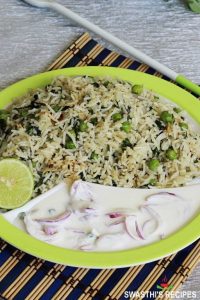Imagine a world where the bold flavors and delicate presentation of traditional Japanese cuisine can be enjoyed without compromising your dietary preferences. Enter vegan Japanese cooking, where creativity meets cultural heritage to create innovative dishes that are not only delicious but also compassionate. In this article, we’ll take you on a culinary journey through 18 flavorful vegan Japanese recipes that will transport your taste buds to the bustling streets of Tokyo and beyond.
From comforting bowls of Miso Ramen with Tofu and Shiitake Mushrooms to savory Vegan Okonomiyaki with Cabbage and Scallions, our selection of plant-based Japanese dishes is sure to satisfy any craving. Whether you’re a seasoned vegan or just looking for some inspiration in the kitchen, these recipes are designed to be easy to follow, packed with flavor, and true to the spirit of Japanese cuisine.
In this article, we’ll delve into the world of vegan Japanese cooking, exploring traditional techniques and ingredients adapted to suit plant-based diets. From popular street foods to comforting home-cooked meals, our 18 recipes showcase the diversity and creativity that vegan Japanese cooking has to offer. So let’s get started on this flavorful adventure!
Miso Ramen with Tofu and Shiitake Mushrooms
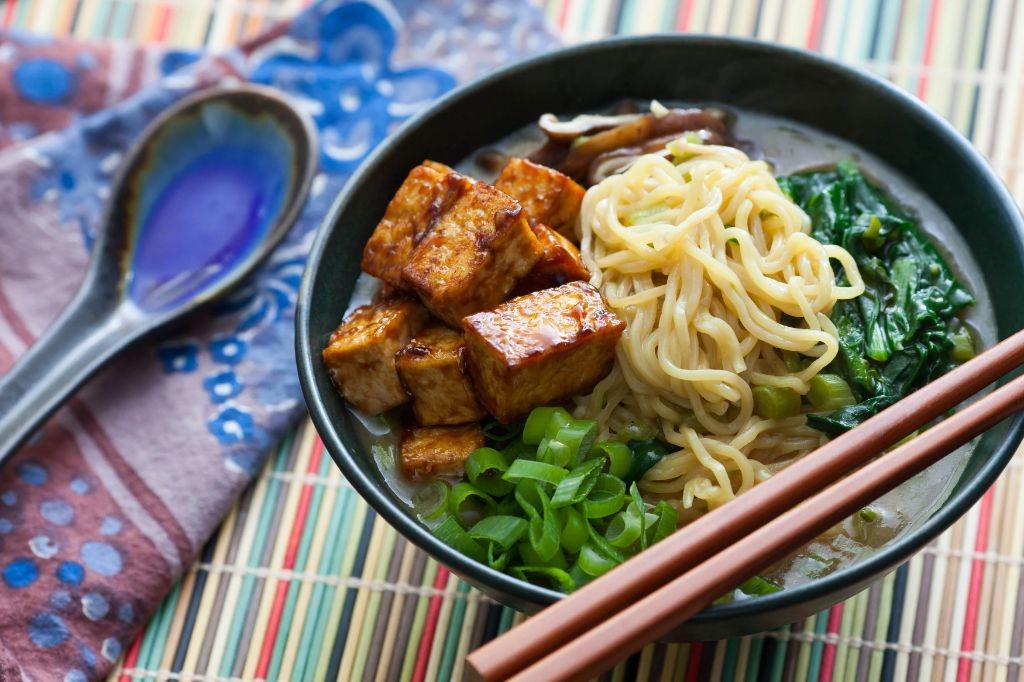
Rich and savory miso ramen noodles come together with tender tofu, earthy shiitake mushrooms, and a depth of flavor from a homemade dashi broth.
Ingredients:
– 1 package ramen noodles
– 2 cups dashi broth (see note)
– 1/2 cup firm tofu, cut into small cubes
– 1/2 cup sliced shiitake mushrooms
– 2 tablespoons white miso paste
– 1 tablespoon soy sauce
– 1 teaspoon sesame oil
– Scallions, thinly sliced for garnish
Instructions:
1. Cook ramen noodles according to package instructions and set aside.
2. In a large pot, combine dashi broth, tofu, mushrooms, miso paste, soy sauce, and sesame oil.
3. Bring the mixture to a simmer over medium heat, whisking occasionally.
4. Reduce heat to low and let cook for 5-7 minutes or until flavors have melded together and tofu is tender.
5. Add cooked noodles to the pot and stir to combine.
6. Serve hot, garnished with thinly sliced scallions.
Cooking Time: 15-20 minutes
Vegan Okonomiyaki with Cabbage and Scallions
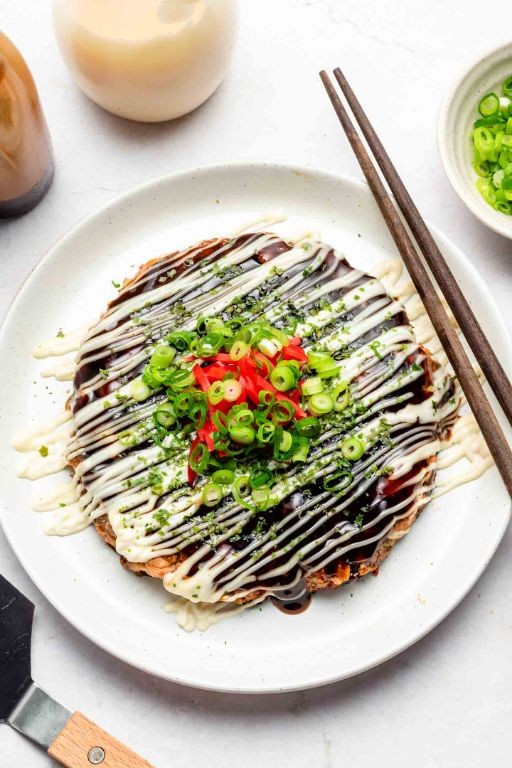
Okonomiyaki, a popular Japanese street food, gets a plant-based twist with this vegan version packed with sautéed cabbage and scallions. This savory pancake is perfect for a quick lunch or dinner.
Ingredients:
– 1 cup all-purpose flour
– 1/2 cup water
– 1/4 cup cornstarch
– 1/4 cup grated tofu (drained and crumbled)
– 1/4 cup finely chopped cabbage
– 2 scallions, thinly sliced
– 1 tablespoon soy sauce
– 1 teaspoon sesame oil
– Salt to taste
– Optional: vegan okonomiyaki sauce, pickled ginger, and sesame seeds for serving
Instructions:
1. In a large bowl, whisk together flour, water, and cornstarch until smooth.
2. Add crumbled tofu, chopped cabbage, scallions, soy sauce, and sesame oil. Mix until well combined.
3. Heat a non-stick pan or okonomiyaki grill over medium heat.
4. Pour in batter and cook for 4-5 minutes on the first side, until edges start to curl.
5. Flip and cook for an additional 2-3 minutes, until golden brown.
6. Serve hot with optional okonomiyaki sauce, pickled ginger, and sesame seeds.
Cooking Time: 8-10 minutes
Teriyaki Eggplant Donburi
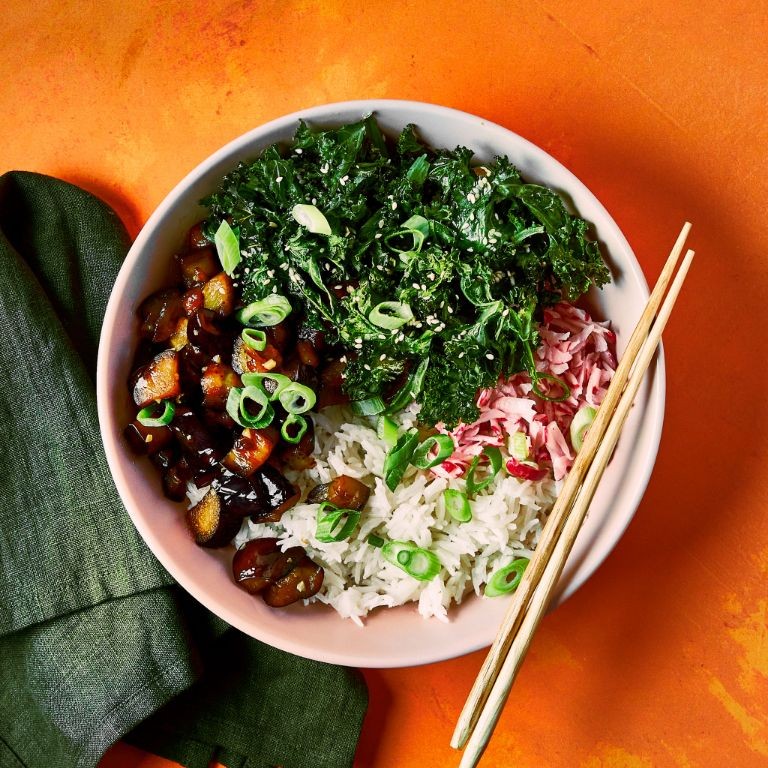
A modern twist on traditional Japanese donburi, this Teriyaki Eggplant Donburi recipe combines sweet and savory flavors with the tender goodness of grilled eggplant.
Ingredients:
– 2 medium eggplants
– 1/4 cup teriyaki sauce
– 1 tablespoon soy sauce
– 1 tablespoon sake (or dry white wine)
– 2 tablespoons brown sugar
– 2 cloves garlic, minced
– 1 teaspoon grated ginger
– 1/4 cup water
– Salt and pepper to taste
– Cooked Japanese rice for serving
Instructions:
1. Preheat grill or grill pan to medium-high heat.
2. Slice eggplants into 1-inch thick rounds.
3. In a small bowl, whisk together teriyaki sauce, soy sauce, sake, brown sugar, garlic, and ginger.
4. Brush the mixture on both sides of the eggplant slices.
5. Grill the eggplant for 3-4 minutes per side, or until tender and slightly charred.
6. Serve grilled eggplant over cooked Japanese rice.
Cooking Time: 15-20 minutes
Avocado and Cucumber Sushi Rolls
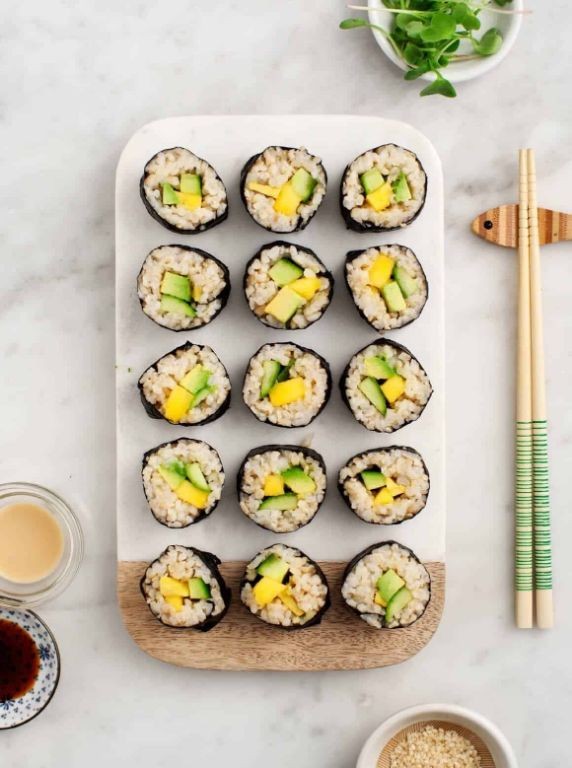
A refreshing twist on traditional sushi rolls, this recipe combines creamy avocado and crisp cucumber with vinegared rice and nori seaweed sheets. Perfect for a light and satisfying snack or meal.
Ingredients:
– 1 ripe avocado, sliced
– 2 cucumbers, peeled and thinly sliced
– 1 cup cooked Japanese short-grain rice (preferably sushi-grade)
– 1/4 cup water
– 1/4 cup rice vinegar
– 1 sheet of nori seaweed
– Sesame seeds or soy sauce for garnish (optional)
Instructions:
1. Prepare the sushi rice according to package instructions, then mix with water and rice vinegar.
2. Lay a nori sheet flat on a cutting board. Spread a thin layer of sushi rice onto the seaweed, leaving a 1-inch border at the top.
3. Arrange avocado slices along the middle of the rice, followed by cucumber slices.
4. Roll the sushi using a bamboo mat or your hands, applying gentle pressure to form a compact roll.
5. Slice into individual pieces and serve with sesame seeds or soy sauce for added flavor.
Cooking Time: 10-15 minutes (including preparation time)
Sweet Potato Tempura with Dipping Sauce

Sweet Potato Tempura with Dipping Sauce Recipe
Experience the crispy delight of Japanese-inspired sweet potato tempura paired with a tangy dipping sauce. This recipe is perfect for a unique appetizer or snack.
Ingredients:
– 2 large sweet potatoes, peeled and cut into 1/4-inch thick rounds
– 1 cup all-purpose flour
– 1/2 cup cornstarch
– 1/2 cup ice-cold soda water
– Vegetable oil for frying
– Dipping Sauce ingredients (see below)
Instructions:
1. In a large bowl, whisk together flour and cornstarch.
2. Gradually add soda water, whisking until smooth batter forms.
3. Dip sweet potato slices into the batter, coating evenly.
4. Heat 2-3 inches of vegetable oil in a deep frying pan over medium-high heat.
5. Fry tempura for 2-3 minutes on each side, or until golden brown.
6. Drain on paper towels.
Dipping Sauce:
– 1/2 cup soy sauce
– 1/4 cup rice vinegar
– 2 tablespoons honey
– 1 tablespoon grated ginger
Combine all dipping sauce ingredients in a bowl and whisk until smooth.
Cooking Time: 10-12 minutes (frying time)
Nasu Dengaku (Miso-Glazed Eggplant)
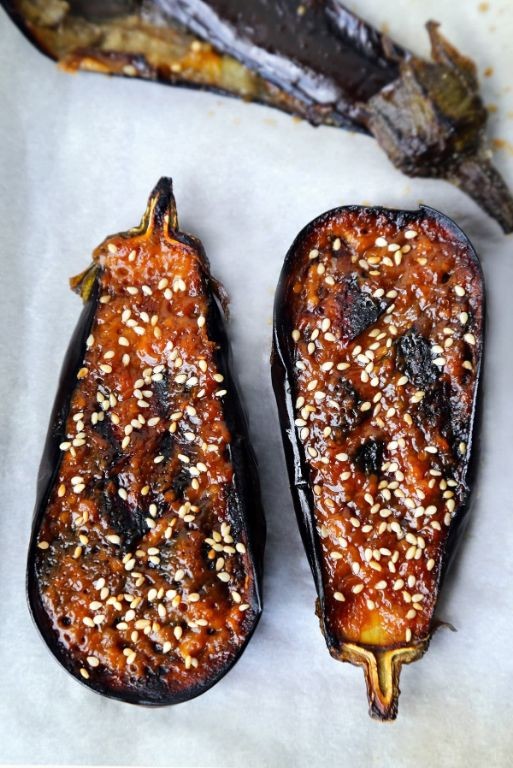
A classic Japanese side dish that perfectly balances sweet and savory flavors, Nasu Dengaku is a must-try for eggplant lovers. This recipe brings together the simplicity of roasted eggplant with the richness of miso glaze.
Ingredients:
– 2 medium eggplants
– 1/4 cup white miso paste
– 2 tablespoons soy sauce
– 2 tablespoons sake (or dry sherry)
– 2 tablespoons mirin (sweet Japanese cooking wine)
– 2 tablespoons sugar
– 1 tablespoon rice vinegar
– 1 teaspoon grated ginger
– Sesame seeds and chopped scallions for garnish (optional)
Instructions:
1. Preheat oven to 400°F (200°C).
2. Cut eggplants in half lengthwise.
3. In a small saucepan, combine miso paste, soy sauce, sake, mirin, sugar, rice vinegar, and grated ginger. Whisk until smooth.
4. Brush the glaze onto the eggplant halves, making sure they’re evenly coated.
5. Roast the eggplants in the preheated oven for 30-40 minutes, or until tender and caramelized.
6. Garnish with sesame seeds and chopped scallions, if desired.
Cooking Time: 30-40 minutes
Vegan Gyoza with Mushroom Filling

Enjoy the savory flavor of homemade gyoza filled with a rich mushroom duxelles, a perfect vegan take on this Japanese classic. These pan-fried or steamed dumplings make a delicious appetizer or snack.
Ingredients:
– 1 package of round wonton wrappers (about 20-24 wrappers)
– 1/2 cup cremini mushrooms, finely chopped
– 1/4 cup tofu, crumbled
– 2 cloves garlic, minced
– 2 tablespoons soy sauce
– 1 tablespoon sesame oil
– 1 teaspoon rice vinegar
– Salt and pepper to taste
Instructions:
1. In a pan over medium heat, sauté the mushrooms, garlic, and sesame oil until the mixture is soft and fragrant.
2. Add the tofu, soy sauce, and rice vinegar. Stir well to combine.
3. Lay a wonton wrapper on a clean surface. Place 1-2 teaspoons of the mushroom filling in the center of the wrapper.
4. Fold the wrapper into a triangle by bringing the two opposite corners together to form a point. Press the edges together to seal the dumpling.
5. Repeat with the remaining wrappers and filling.
6. Pan-fry or steam the gyoza according to your preference.
Cooking Time:
– Pan-frying: 2-3 minutes per side, until golden brown
– Steaming: 4-5 minutes, until cooked through
Kinpira Gobo (Braised Burdock Root)
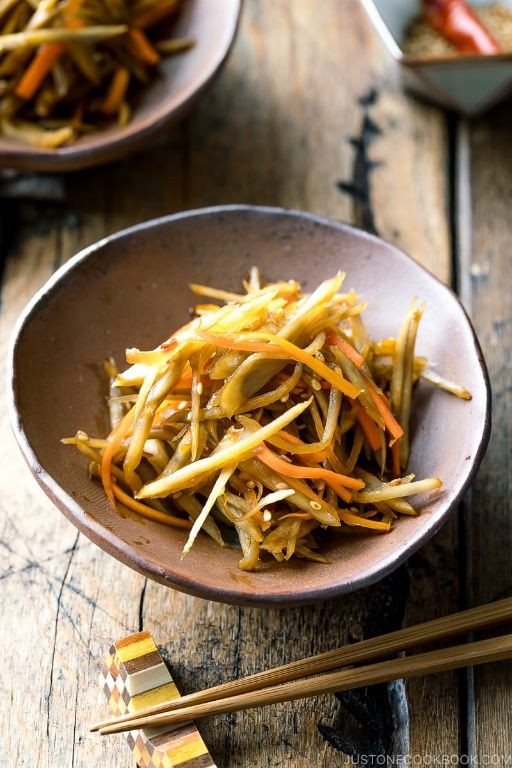
Kinpira Gobo is a traditional Japanese dish that highlights the nutty flavor and tender texture of burdock root. This simple braising method brings out the best in this underrated ingredient.
Ingredients:
– 1 large burdock root, peeled and cut into 1-inch pieces
– 2 tablespoons soy sauce
– 2 tablespoons sake (or dry white wine)
– 1 tablespoon mirin (sweet Japanese cooking wine)
– 1 tablespoon sugar
– 2 cloves garlic, minced
– 1/4 cup vegetable oil
– Sesame seeds and chopped scallions for garnish (optional)
Instructions:
1. In a large saucepan or Dutch oven, heat the oil over medium heat.
2. Add the burdock root pieces and cook until they start to brown, about 5 minutes.
3. Add the soy sauce, sake, mirin, sugar, and garlic. Stir to combine.
4. Reduce heat to low and simmer, covered, for 30-40 minutes or until the burdock is tender and caramelized.
5. Season with salt to taste.
6. Garnish with sesame seeds and chopped scallions, if desired.
Cooking Time: 40 minutes
Tofu Katsu with Tonkatsu Sauce
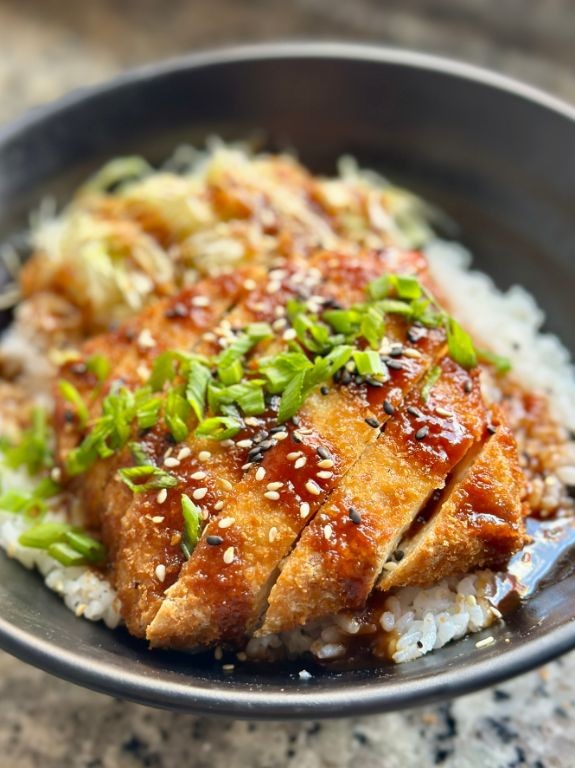
Elevate your vegan game with this Japanese-inspired twist on the classic pork katsu. Crispy tofu coated in breadcrumbs, fried to perfection and served with a rich and creamy tonkatsu sauce.
Ingredients:
– 1 block of firm tofu, drained and cut into slices
– 1 cup all-purpose flour
– 1/2 cup panko breadcrumbs
– 1 egg replacement (such as Ener-G Egg Replacer or flaxseed mixed with water)
– Vegetable oil for frying
– Tonkatsu sauce (homemade or store-bought)
Instructions:
1. In a shallow dish, mix together flour and panko breadcrumbs.
2. Dip each tofu slice into the egg replacement, then coat in the breadcrumb mixture, pressing gently to adhere.
3. Heat about 1/2 inch of vegetable oil in a large skillet over medium-high heat. Fry coated tofu slices until golden brown, about 3-4 minutes per side.
4. Drain excess oil and serve hot with tonkatsu sauce.
Cooking Time: About 15-20 minutes (depending on frying time).
Vegan Chawanmushi (Steamed Savory Custard)

Vegan Chawanmushi Recipe: A Savory Steamed Custard Delight
Chawanmushi is a traditional Japanese savory custard dish, typically steamed and served as an appetizer or side dish. This vegan version substitutes dairy with plant-based ingredients for a rich and creamy texture.
Ingredients:
– 1 cup firm tofu, drained and crumbled
– 1/2 cup soy milk
– 1/4 cup cornstarch
– 1/4 cup grated carrot
– 1/4 cup chopped green onion
– 2 tablespoons soy sauce
– 1 tablespoon sesame oil
– Salt and pepper to taste
– Chopped scallions for garnish (optional)
Instructions:
1. In a blender, combine tofu, soy milk, cornstarch, grated carrot, green onion, soy sauce, and sesame oil. Blend until smooth.
2. Pour the mixture into small individual cups or ramekins.
3. Steam the chawanmushi over boiling water for 12-15 minutes, or until set.
4. Remove from heat and let cool slightly. Serve warm or at room temperature, garnished with chopped scallions if desired.
Cooking Time: 12-15 minutes
Yaki Onigiri (Grilled Rice Balls with Soy Glaze)
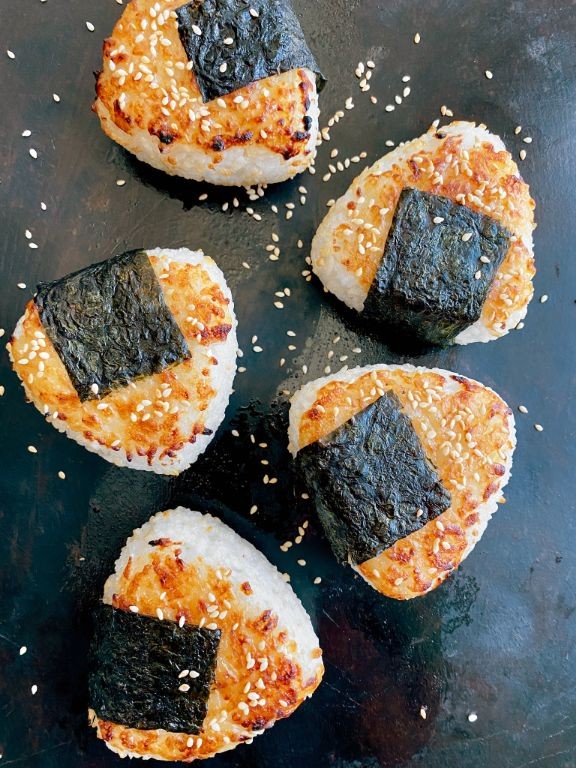
Discover the perfect fusion of Japanese flavors with this simple and delicious recipe for grilled rice balls, smothered in a sweet and savory soy glaze. This popular snack is a staple at Japanese festivals and events.
Ingredients:
– 2 cups cooked Japanese short-grain rice (preferably day-old)
– 1/4 cup water
– 1/2 teaspoon salt
– 1/4 teaspoon sugar
– 1/2 cup soy sauce
– 1/4 cup sake or dry white wine
– 2 tablespoons mirin
– Vegetable oil for brushing
Instructions:
1. Mix rice with water, salt, and sugar until well combined.
2. Shape into small balls (about 1 1/2 inches in diameter).
3. Brush the grill or grill pan with vegetable oil to prevent sticking.
4. Grill onigiri for 5-7 minutes per side, or until lightly browned.
5. In a small saucepan, combine soy sauce, sake, and mirin. Bring to a simmer over medium heat.
6. Glaze grilled onigiri with the warm soy glaze and serve immediately.
Cooking Time: 15-20 minutes
Shiitake and Bamboo Shoot Nimono
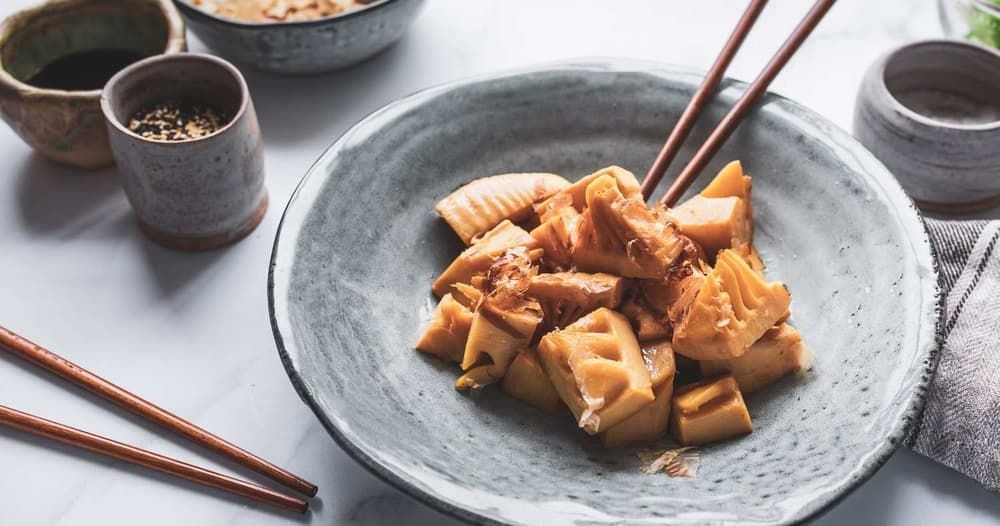
Nimono is a traditional Japanese cooking method that results in tender, flavorful ingredients. This recipe combines the earthy flavor of shiitake mushrooms with the sweet crunch of bamboo shoots for a delicious side dish.
Ingredients:
– 1 cup dried shiitake mushrooms
– 2 cups water
– 2 tablespoons soy sauce
– 2 tablespoons sake (or dry white wine)
– 2 tablespoons mirin (sweet Japanese cooking wine)
– 1/4 cup sliced bamboo shoots, fresh or canned
– 2 tablespoons sesame oil
– Salt and pepper to taste
Instructions:
1. Rinse the dried shiitake mushrooms and soak them in hot water for at least 30 minutes.
2. Drain the mushrooms and combine with the remaining ingredients in a saucepan.
3. Bring the mixture to a boil, then reduce heat and simmer for 20-25 minutes or until the mushrooms are tender.
4. Add the sliced bamboo shoots during the last 5 minutes of cooking.
5. Season with salt and pepper to taste.
6. Serve warm or at room temperature.
Cooking Time: 30-35 minutes
Vegan Zaru Soba with Dipping Broth
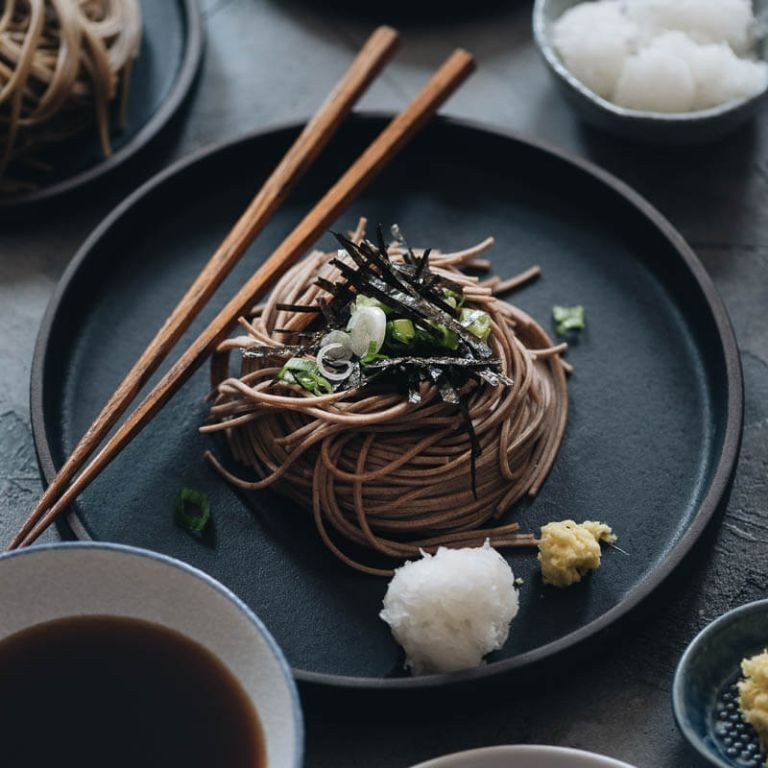
Rejuvenate your senses with this simple yet satisfying Japanese-inspired dish. Vegan Zaru Soba pairs perfectly cooked buckwheat soba noodles with a light and refreshing dipping broth.
Ingredients:
– 1 package vegan soba noodles (zaru)
– 2 tablespoons soy sauce
– 2 tablespoons rice vinegar
– 1 tablespoon sesame oil
– 4 cups water
– Optional: sliced green onions, grated ginger, or pickled ginger for garnish
Instructions:
1. Cook the soba noodles according to package instructions. Drain and set aside.
2. In a large bowl, whisk together soy sauce, rice vinegar, and sesame oil.
3. Add the cooked soba noodles to the bowl and toss to combine.
4. For the dipping broth, bring the water to a boil in a separate pot. Reduce heat to low and simmer for 5 minutes.
5. Strain the broth through a fine-mesh sieve into a serving bowl. Discard solids.
6. Serve the soba noodles with the warm dipping broth and garnish with your choice of optional ingredients.
Cooking Time: 15-20 minutes
Kabocha Squash Simmered in Soy and Mirin
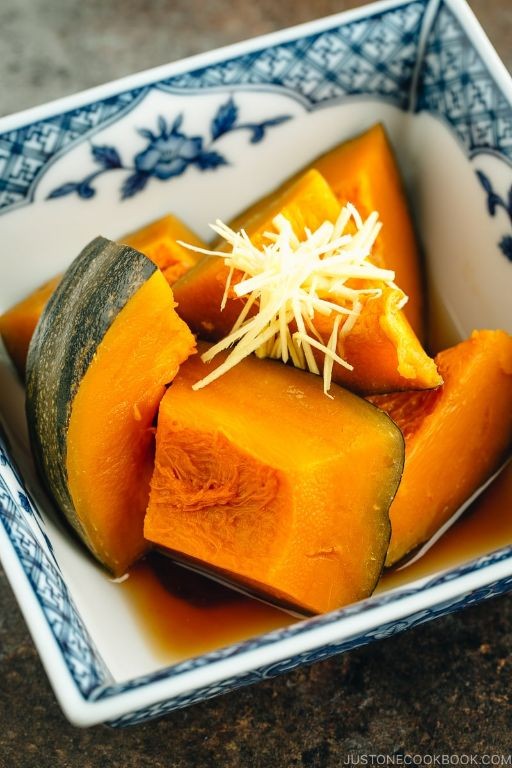
A simple and flavorful Japanese-inspired side dish, perfect for accompanying grilled meats or as a topping for rice bowls.
Ingredients:
– 1 medium kabocha squash (about 2 lbs), peeled and cubed
– 1/4 cup soy sauce
– 2 tablespoons mirin
– 1 tablespoon sugar
– 1/4 teaspoon salt
– 2 tablespoons water
Instructions:
1. In a large saucepan, combine the cubed kabocha squash, soy sauce, mirin, sugar, and salt.
2. Add the water to the pan, making sure that the squash is covered by about an inch of liquid.
3. Bring the mixture to a simmer over medium heat, then reduce the heat to low and let cook for 30-40 minutes, or until the squash is tender and caramelized.
4. Stir occasionally to prevent scorching.
Cooking Time: 30-40 minutes
Sunomono (Cucumber and Wakame Salad)
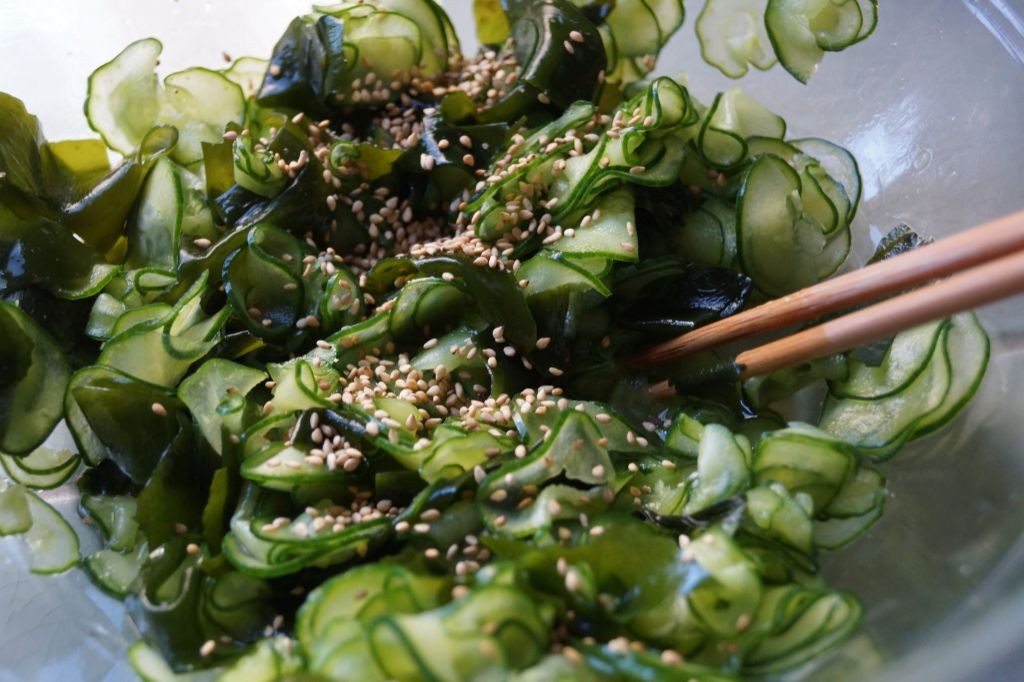
Sunomono is a classic Japanese side dish that pairs perfectly with sushi or as a light and refreshing snack. This recipe combines the crispness of cucumbers with the nutty flavor of wakame seaweed.
Ingredients:
– 2 large cucumbers, thinly sliced
– 1/4 cup wakame seaweed, rehydrated and chopped
– 1/4 cup rice vinegar
– 2 tablespoons sugar
– 1 tablespoon salt
– 1/4 cup water
– Sesame seeds and grated daikon (optional)
Instructions:
1. In a large bowl, combine the sliced cucumbers and chopped wakame seaweed.
2. In a small saucepan, combine the rice vinegar, sugar, and salt. Heat over low heat until the sugar dissolves.
3. Pour the warm vinegar mixture over the cucumber mixture. Let it sit for at least 30 minutes to allow the flavors to meld.
4. Just before serving, stir in the water and adjust the seasoning if needed.
5. Garnish with sesame seeds and grated daikon, if desired.
Cooking Time: 30 minutes (including marinating time)
Vegan Katsudon with Seitan Cutlet

Vegan Katsudon with Seitan Cutlet Recipe
Summary:
This recipe is a vegan twist on the classic Japanese dish, tonkatsu, which typically features a breaded and fried pork cutlet. In this version, we replace the pork with seitan and serve it in a savory broth with rice and vegetables.
Ingredients:
– 1 package of store-bought or homemade seitan
– 1 cup all-purpose flour
– 1/2 cup cornstarch
– 1/4 cup breadcrumbs
– 1 tablespoon vegetable oil
– 2 cloves garlic, minced
– 1 onion, thinly sliced
– 2 cups vegetable broth
– 1 cup cooked Japanese rice
– 1/2 cup mixed vegetables (such as carrots, green beans, and bell peppers)
– Salt and pepper to taste
Instructions:
1. Cut the seitan into thin cutlets.
2. In a shallow dish, mix together flour, cornstarch, and breadcrumbs.
3. Dip each seitan cutlet in the breadcrumb mixture, pressing gently to adhere.
4. Heat the vegetable oil in a large skillet over medium-high heat. Cook the breaded seitan for 3-4 minutes on each side, or until golden brown.
5. In a separate pot, combine vegetable broth, garlic, and onion. Bring to a simmer.
6. Serve the cooked seitan cutlets with Japanese rice and mixed vegetables in the broth.
Cooking Time:
30-40 minutes
Gomaae (Spinach with Sesame Dressing)

Gomaae is a classic Korean side dish made with spinach, sesame oil, and toasted sesame seeds. This refreshing salad is perfect for accompanying rice bowls, noodle dishes, or as a snack on its own.
Ingredients:
– 1 bunch of fresh spinach (about 4 cups)
– 2 tablespoons of sesame oil
– 2 tablespoons of Gochujang (Korean chili paste)
– 1 tablespoon of soy sauce
– 1 teaspoon of sugar
– 1/4 cup of toasted sesame seeds
Instructions:
1. Rinse the spinach and drain well.
2. In a large bowl, whisk together sesame oil, Gochujang, soy sauce, and sugar until smooth.
3. Add the spinach to the bowl and toss to coat with the dressing.
4. Sprinkle toasted sesame seeds on top of the spinach.
5. Serve immediately.
Cooking Time: 10 minutes
Vegan Matcha Green Tea Mochi

Experience the perfect blend of Japanese tradition and plant-based innovation with this vegan matcha green tea mochi recipe. Soft, chewy mochi filled with a vibrant green tea filling – it’s a delightful treat for any time of day.
Ingredients:
– 1 cup glutinous rice flour
– 1/2 cup cornstarch
– 1/4 cup matcha powder
– 1/4 cup sugar
– 1/2 cup water
– 1/4 teaspoon salt
– Vegan green tea filling (see below)
– Confectioners’ sugar for dusting
Vegan Green Tea Filling:
– 1/2 cup unsweetened soy milk or other non-dairy milk
– 1 tablespoon matcha powder
– 1 tablespoon maple syrup
– 1/4 teaspoon vanilla extract
Instructions:
1. In a large mixing bowl, combine glutinous rice flour, cornstarch, and sugar.
2. Gradually add in water while kneading the mixture until a dough forms.
3. Divide the dough into small balls, about the size of a golf ball.
4. Flatten each ball into a disk shape.
5. Place 1-2 teaspoons of vegan green tea filling in the center of each disk.
6. Fold the dough over the filling to form a triangle or square shape.
7. Dust with confectioners’ sugar and serve.
Cooking Time: None, as this recipe is for a no-bake dessert.
Summary
Discover the delicious and authentic flavors of Japanese cuisine with these 18 vegan recipes. From classic dishes like miso ramen and teriyaki eggplant donburi to unique twists like avocado sushi rolls and sweet potato tempura, there’s something for every taste bud. These innovative and easy-to-follow recipes use plant-based ingredients to recreate traditional Japanese flavors, from savory gyoza and tonkatsu sauce to refreshing sunomono and matcha mochi. Get ready to experience the bold and aromatic flavors of Japan without compromising on your vegan diet.
